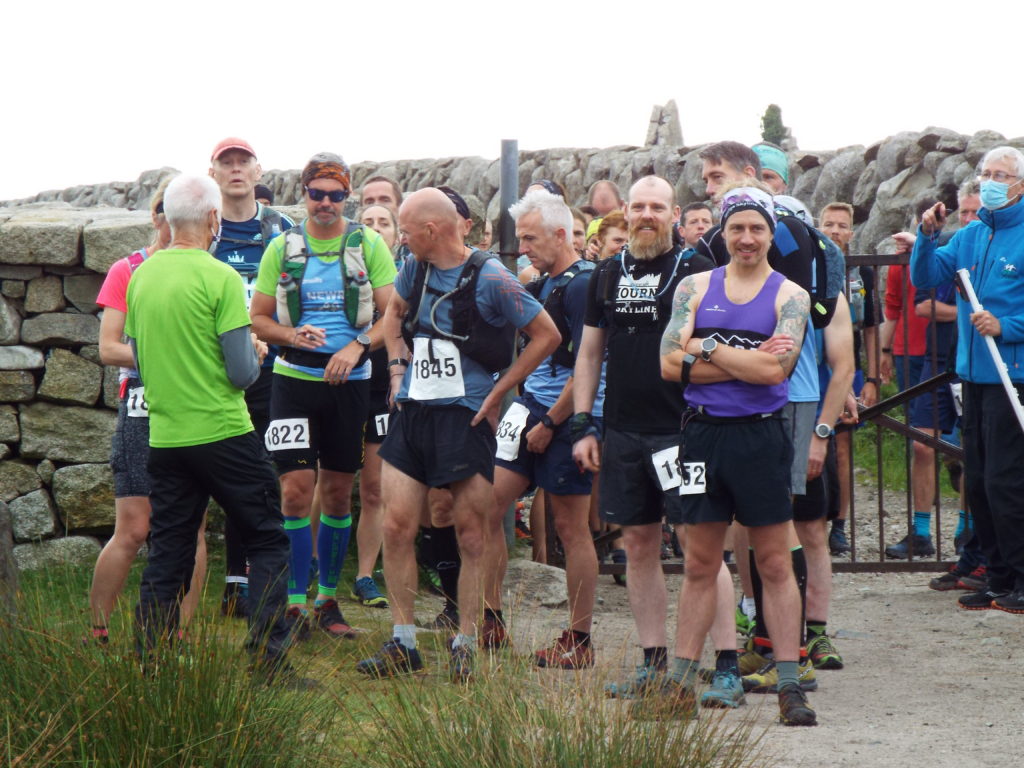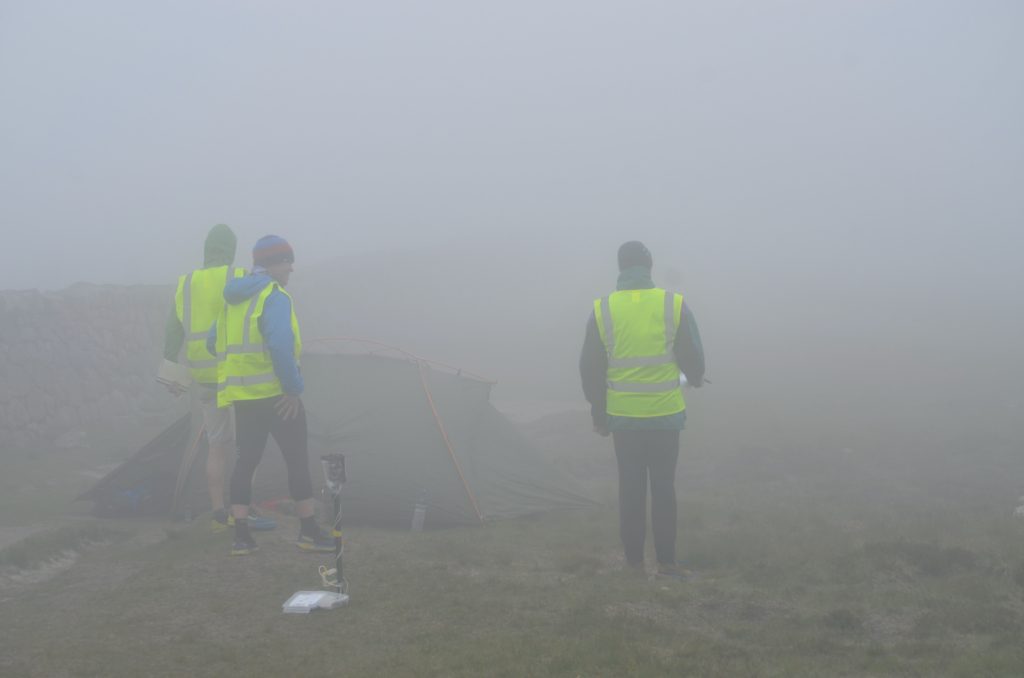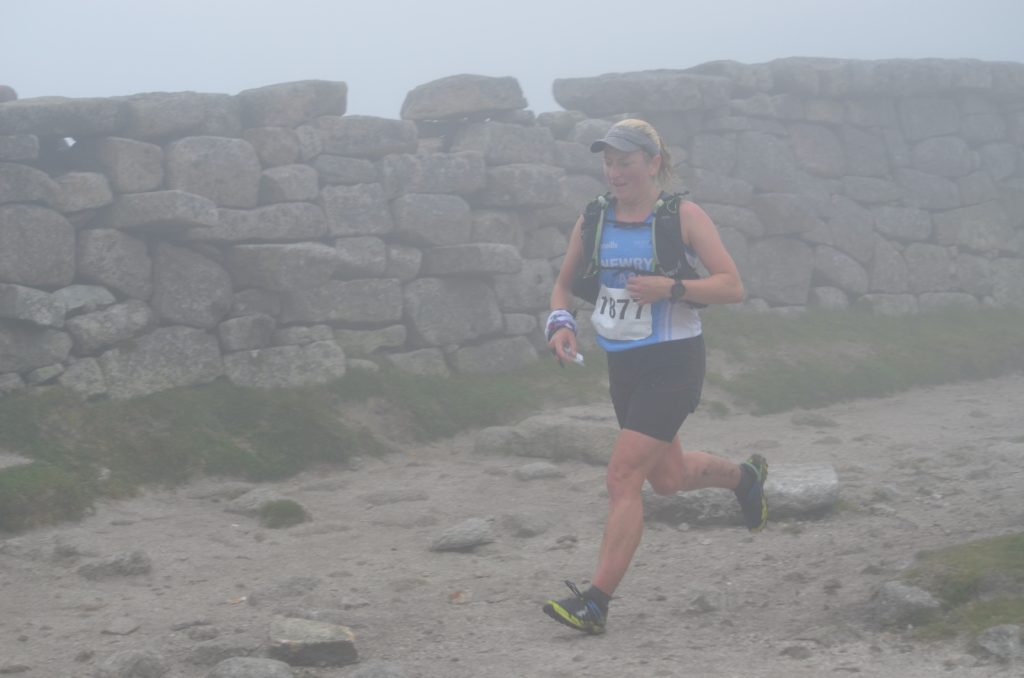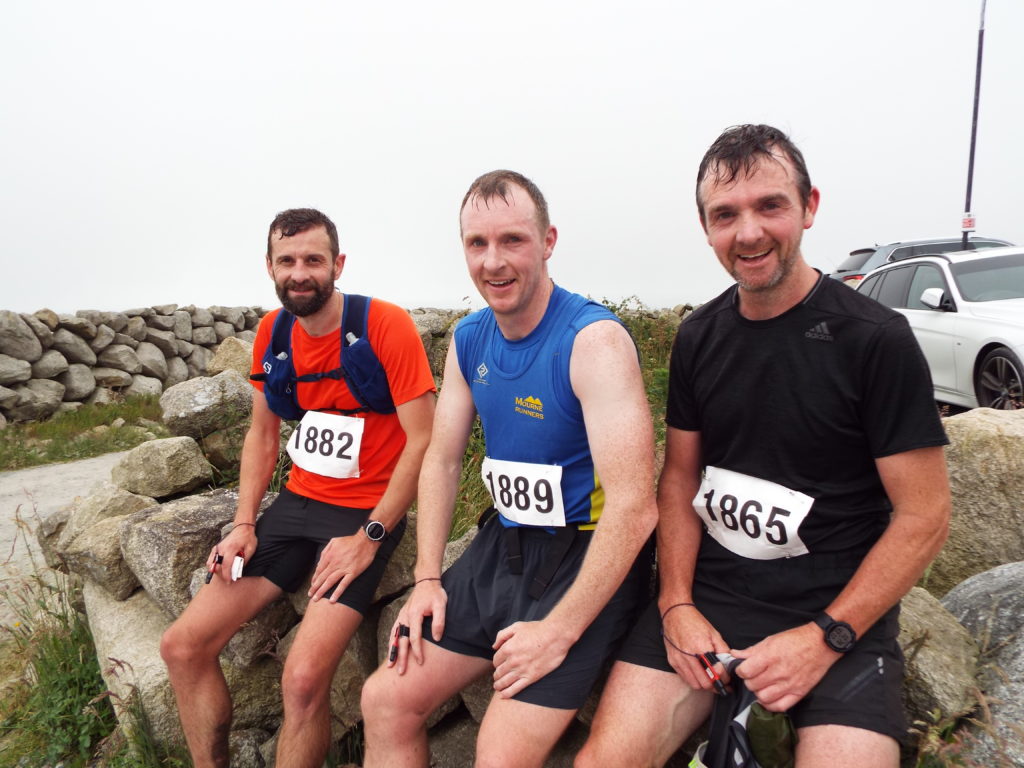
WE’RE BACK!! Fellrunning returned to the Mournes on Saturday 03rd July for the first time this year. With a new venue, revised race route, a record number of entrants (116) and Covid restrictions to manage, the race organisers were kept busy in the weeks before the race. This race was the first long category race, 20km and 2000m of ascent, in the 2021 NIMRA championship.
In 2019 the race venue moved to the Silent Valley complex, with a revised race route that ran most of the traditional route in reverse. This year, access to the Silent Valley complex wasn’t available due to Covid restrictions so the organisers moved the race venue to the Carricklittle Camping complex at the top of the Carricklittle track. This year’s race route resorted to the traditional route, run in the traditional direction as much as was possible, with a few tweaks on the first and last legs to accommodate the new venue. With ample parking at the race venue and in surrounding car parks, the organisers felt that this new venue will solve the car parking problems that the increasing number of participants posed at the traditional Dunnywater complex.

Of the 116 pre-entered participants, 96 eager runners turned up to run on the day, most nervously watching as low-level mist enveloped the mountains. The mist was to stay in place all day, thickening as the day progressed. A new race venue and start location meant that most of the pre-race discussions centred around the best route to the first checkpoint on Chimney. To go right or left around Rocky, to go further along the track to Hares Castle, the benefits and drawbacks of each route were being debated. In the end, it was the mist and the navigational challenge that this presented that would be decisive in the race outcome.
With runners split into groups of 15 setting off at 30 second intervals, rather than the traditional mass start, the runners were quickly underway, making their way north along the Carricklittle track to the first checkpoint on Chimney summit. Timmy Johnston was first through the checkpoint, closely followed by Ryan Stewart and Johnny Scott. The first lady at Chimney was Martsje Hell, with Esher Dickson 15 seconds behind.
To get to the next checkpoint on the summit of Slieve Donard, the runners have to cross the Bog of Donard. As its name suggests, the going can be quite soft across this area, particularly if anyone deviates from the main track along the ridge line. Martsje Hell, still the leading female runner, veered too far to the right, meaning that she had to cross a soft part of the bog. While she was traversing a particularly boggy patch, Martsje came across a sheep which had face planted into the bog with front legs embedded in the mire up to its oxsters. The sheep was in obvious distress struggling to breathe, with its face planted in the bog and didn’t appear to be able to extract itself. Luckily, Martsje’s day job as a vet allowed her to quickly assess the situation, she stopped, grabbed the sheep by the horns and a couple of swift tugs later, a bemused sheep was standing on firm ground, watching its slightly built rescuer legging it off into the mist towards the next checkpoint.

On the summit of Slieve Donard, Ryan Stewart was seconds ahead of Timmy Johnston, with Adam Cunningham moving up into 3rd place. In the ladies race, Esther had taken advantage of Martsje’s sheep rescuing diversion to move ahead into first place, all be it by less than a minute. Esther used her descending speed to record the fastest descent time of the day between Donard summit and the Donard/Commedagh col (an impressive 4:08 minutes) to stretch her lead in the ladies category.

At the next checkpoint on Commedagh summit, the leading male and female positions remained unchanged. The route to the next checkpoint involves retracing the race route to cross the stile at the Mourne Wall and then undertake the very steep and fast descent toward the Slieve Beg col, the natural crossing point. The natural slope of the Commedagh descent leads away off to the west where you want to cross at the col, which isn’t a problem in good visibility but requires astute work with a compass in poor visibility. With Johnston and Stewart running neck-and-neck for the race lead, they decided that there was no time to check compass bearings and they raced off down the slope, side by side but in the wrong direction. The mist was so thick and they were so concentrated in racing each other, they didn’t notice that they had crossed the Brandy Pad and it was only when they ended up in the ravine between the Brandy Pad and Slieve Beg that they realised that it had all gone wrong. By the time they had worked out where they were and got back on to the race route, all chance of victory had gone and both decided to retire. Adam Cunningham was in third place at Commedagh summit and while only a minute behind the two leaders, couldn’t see them due to the mist and had used his compass to good effect to stay on the race route and take the race lead.
In the ladies race, Esther was in the lead at Commedagh summit and used her fast descending pace to quickly run off in the wrong direction, repeating the mistake of Johnston and Stewart. By the time she had got back on track, Martsje was over nine minutes ahead and this lead was to prove unassailable, with a disheartened Esther, thinking that she had dropped away down the field and not realising that she was still second lady, deciding to retire after the Lamigan checkpoint.

These navigational mistakes were by no means confined to the front runners. Lots of runners further down the field were being navigationally challenged all around around the route, lots of tales afterwards of unintended route choices. One experienced runner related how she had successfully navigated to the Slieve Beg col (when the race leaders didn’t), to ascend Slieve Beg, do an unintentional 180 turn and run all the way down again, start climbing Commedagh (thinking it was Cove) only to realise her mistake as the ground conditions didn’t resemble what she was expecting, losing nearly 30 minutes in the process.
Meanwhile, Adam Cunningham continued to lead the race all the way to the finish, emerging out of the mist to cross the finish line a slightly bemused but delighted winner. Adam had no idea of what was going on around him in regards to other runners, pushing on at race pace through the last few checkpoints to record what turned out to be a very comfortable victory in a winning time of 2:27, 14 minutes ahead of the second place runner.
In the race for second, with the retirements of Johnson and Stewart, Jonny Scott moved up into second place, with Andrew Tees just over half a minute behind in third at the Cove checkpoint. At the next checkpoint on Lamigan, Andrew had been overhauled by Clive Bailey, who was in turn only twenty seconds ahead of younger brother Gary.

By the final checkpoint at the North Tor on Binian, Jonny Scott had made a major navigational error, losing over 12 minutes and dropping from 2nd place to 8th. Clive moved up into second place, with Gary moving into third place ahead of a tiring Andrew Tees. On the run in to the finish, the younger Bailey brother managed to out-sprint his elder, claiming second position by 10 seconds, Andrew Tees of Orangegrove finishing in 4th place overall, a further minute behind. Congratulations to Mourne Runners, their club members filling the first three places.
In the ladies race, Martsje Hell of North Belfast Harriers maintained her lead all the way to the finish, recording a time of 2:57 and a very respectable 9th overall position. With Esther Dickson retiring from second place on Slieve Lamigan, Debbie McConnell of Jog Lisburn was second lady (30th o/a) in a time of 3:32, Jackie Toal from host club B.A.R.F. claiming 3rd lady in a time of 3:39 (33rd o/a).

Congratulations to the age category winners – MV40 – Gary Bailey (2nd); MV45 – Clive Bailey (3rd); MV50 Pete Grant (23rd); MV55 – Dale Mathers (12th); MV60 – Eugene McCann (40th); MV70 – Ricky Cowan (70th); MV75 Ian McCullough (79th); FV40 Ciara Coffey (41st); FV45 Amanda Perry (65th); FV50 Jackie Toal (33rd); FV55 Denise Mathers (43rd).

There were 96 starters and 85 finishers. All runners made the cut-off time, despite the poor visibility. Finishing times ranged from 2:27 to 6:04 and all retired runners reported to the start/finish area. Well done to all of the runners who took part.
A special thanks to Mourne Mountain Rescue team for their assistance. One of our runners got disorientated and was unsure of their location. A phone call from the runner to the MMR team allowed them to locate their position using mobile phone tracing technology, which allowed the runner to reorientate and navigate to the finish area. MMR contacted the race organisers to advise of the runner’s plight, who sent a team to intercept the runner, to ensure safe return.
In line with Covid precautions there was no prize giving and no refreshments were on offer after the race.
The real winner on the day was Fell Running – all of the runners were delighted to be back racing in the Mournes again after an almost two year hiatus. At the finish line, the delight of all of the finishers was palatable right throughout the field, adrenaline was clearly still flowing well after the finishing times as runners recounted their experiences, generally all related to the poor visibility and the navigational challenge the conditions presented, although there were a few impressively cut knees on show.

Congratulations to our male and female winners, Adam Cunningham winning his first ever race and Martsje Hell recording her second victory on this course as ladies race winner.
It was disappointing to still see runners failing to present the appropriate safety kit at the kit check, mainly jackets. We had 10 runners who presented jackets without taped seams (the definition of being waterproof), one such jacket had no hood. One runner had no map, for a race in the mist! The latest thing to amaze us was a compass the size of a (new) half penny on a wrist band. We will now amend our minimum kit description to read ‘a suitable compass’ i.e. one that you can actually use to take and read a bearing from. Weather conditions for this race were misty, 15 degree temperature (at start/finish area), dry and no wind. Yet most runners who were out over 3:30 hours were wearing their jackets over the finish line. Your safety kit must be suitable for the conditions. A paper thin, taped seams Innov8, Salomon etc very lightweight jacket is not going to be suitable for a long race in poor weather conditions. Runners are advised to bring a selection of equipment to cover all weather eventualities to the race venue. Remember that the Race Organisers decision on the suitability of safety kit is final. Having the correct gear when out in the mountains could save your life.
A big thank you to all of the marshals who volunteered at the marshalling checkpoint and to all the help and assistance provided by the members of the B.A.R.F. organising club in the start and finish area. We couldn’t run the race without all of your help.
Thank you to Carricklittle Camping for accommodating us. All of the organising team look forward to welcoming everybody back again next year, on our traditional May date, for the 2022 version of this race, same venue, same route.
Trevor Wilson
Race Organiser
B.A.R.F.
